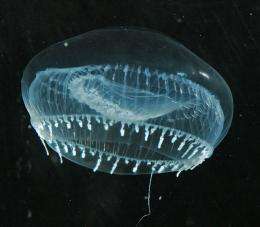Aequorea victoria. Image credit: Sierra Blakely/Wikipedia.
(Phys.org) —A team of researchers in the U.S. has found that jellyfish are extremely efficient swimmers. In their paper published in Proceedings of the National Academy of Sciences, the team reports using a technique called particle image velocimetry to measure the secondary thrust jellyfish use to increase their energy efficiency when swimming.
For years, jellyfish have been considered a nuisance—they sting swimmers and crowd out other more desirable ocean dwellers. In more recent times, they have become even more of a problem as they grow in both numbers and size—most scientists attribute this to their adaptability to warmer ocean temperatures and a decrease in other populations due to overfishing by humans. Now, it appears they have another natural advantage that gives them an edge over other ocean dwelling creatures as well—they are far more efficient when swimming leaving them more energy to find food and mate.
Scientists have known for a long time that jellyfish move through the water by squeezing the bell that forms ahead of their body. That squeezing pushes water backwards forcing the jellyfish forward. More recently it has been learned that they also are pushed forward by a secondary thrust that occurs as the bell is refilling with water. Until now, however, it was unknown just how much benefit jellyfish got from this.
DPIV of a 2-cm A. aurita jellyfish shows the velocity vectors and vorticity produced by swimming. Notice how the stopping vortex forms upstream and on the exumbrellar surface of the animal before recovery. The vortex ring then moves under the bell as its vorticity (energy) increases. Credit: PNAS, Published online before print October 7, 2013, doi: 10.1073/pnas.1306983110
To find out, the researchers anesthetized some test specimens and placed them in a tank filled with very tiny glass beads. As the jellyfish moved in the beads, a laser was shone and reflected off the beads, allowing the researchers to measure its speed and how much energy the creature was expending as it moved. They noted that immediately after squeezing its bell, a vortex formed as the bell relaxed. That vortex pushed against the jellyfish's body, propelling it forward. More importantly, the researchers found that the secondary thrust required no energy expenditure by the jellyfish at all—it was purely mechanical, like a rubber-band snapping back to its original size after being stretched. That extra boost the researchers report (which averaged about a thirty percent gain) means that jellyfish are by far the most efficient swimmers in the sea, giving them an advantage over virtually all other sea life.
Instantaneous pressure field estimations are shown simultaneously with body velocity to demonstrate a mechanistic explanation for how jellyfish can accelerate, and thus gain extra distance, during a period of the swimming cycle in which there is no kinematic motion. Credit: PNAS, Published online before print October 7, 2013, doi: 10.1073/pnas.1306983110
The findings may lead to increases in efficiency in swimming robots as scientists seek to recreate the mechanics of jellyfish—that could mean swimming robots plying the seas sending back data for years on end, or as some have suggested, new kinds of robots that kill real jellyfish.
More information: Passive energy recapture in jellyfish contributes to propulsive advantage over other metazoans, PNAS, Published online before print October 7, 2013, DOI: 10.1073/pnas.1306983110
Abstract
Gelatinous zooplankton populations are well known for their ability to take over perturbed ecosystems. The ability of these animals to outcompete and functionally replace fish that exhibit an effective visual predatory mode is counterintuitive because jellyfish are described as inefficient swimmers that must rely on direct contact with prey to feed. We show that jellyfish exhibit a unique mechanism of passive energy recapture, which is exploited to allow them to travel 30% further each swimming cycle, thereby reducing metabolic energy demand by swimming muscles. By accounting for large interspecific differences in net metabolic rates, we demonstrate, contrary to prevailing views, that the jellyfish (Aurelia aurita) is one of the most energetically efficient propulsors on the planet, exhibiting a cost of transport (joules per kilogram per meter) lower than other metazoans. We estimate that reduced metabolic demand by passive energy recapture improves the cost of transport by 48%, allowing jellyfish to achieve the large sizes required for sufficient prey encounters. Pressure calculations, using both computational fluid dynamics and a newly developed method from empirical velocity field measurements, demonstrate that this extra thrust results from positive pressure created by a vortex ring underneath the bell during the refilling phase of swimming. These results demonstrate a physical basis for the ecological success of medusan swimmers despite their simple body plan. Results from this study also have implications for bioinspired design, where low-energy propulsion is required.
Journal information: Proceedings of the National Academy of Sciences
© 2013 Phys.org























